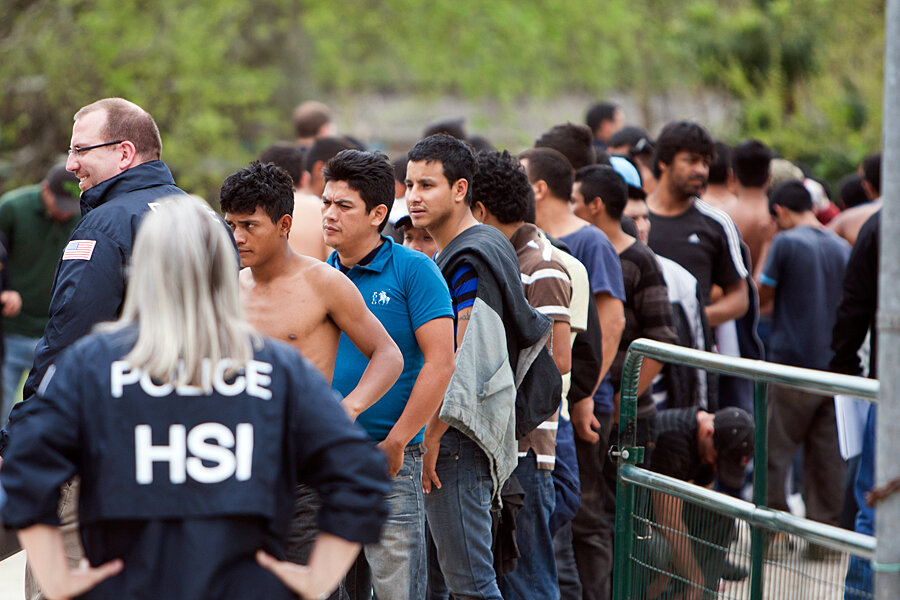100 found in Houston 'stash house' – horrors routine, but on bigger scale
Loading...
The images of more than 100 men, women, and children held for ransom by suspected smugglers in a filthy Houston-area “stash house” are shocking. But the terrifying ordeal is not surprising, immigrant advocates say.
“The scope of this is incredible … but this happens on a smaller scale with great frequency,” says Cecelia Friedman Levin, a staff attorney at ASISTA Immigration Assistance in Des Moines, Iowa. “Individuals who are crossing the border in this way are subject to a tremendous amount of exploitation.”
Often that exploitation stays in the shadows. But in this case, five suspects were arrested Wednesday on suspicion of human smuggling and possible other crimes. A tip came into police from relatives of a woman and two small children who were not dropped off Tuesday as had been arranged.
After police found the people crammed into the squalid house, two were hospitalized Wednesday and the rest were taken into custody by US Immigration and Customs Enforcement to be fed and questioned, ICE spokesman Greg Palmore said. They were primarily from Guatemala, Mexico, Honduras, and El Salvador, and appear to have been victims of a trafficking ring, he said.
What happens next likely will depend on people’s individual circumstances and the discretion of ICE officials, immigration experts say. Some of them may be deported quickly, while others may qualify for special visas intended to encourage undocumented immigrants who have been victims of serious crimes to help in the investigation and prosecution. Still others may qualify for help available to unaccompanied minors and victims of sexual violence.
In a group that large, officials will also have to investigate whether some of the people rounded up may have been assisting to hold others captive, says Michael A. Olivas, who teaches immigration law and policy at the University of Houston Law Center.
It’s unlikely that mental health assistance or pro bono legal counsel will be available for most of the victims, because demand for such services far outweighs supply, Professor Olivas says.
ICE does have victim witness specialists to work with people in the context of trafficking cases. But the Monitor could not reach ICE Thursday for comment on whether such specialists are available in this case.
In 2000, as part of the Victims of Trafficking and Violence Protection Act, Congress set up two categories of visas, known as U and T, for victims of a specified list of crimes who experienced substantial harm and would be helpful in prosecuting the crime. Among the listed crimes that could potentially be relevant in this case: kidnapping, holding someone hostage, extortion, false imprisonment, and trafficking.
However, law enforcement officials have to certify that someone qualifies for such a visa. “I would hope that ICE would offer that, but I wouldn’t be surprised if they didn’t,” says Suzanne Tomatore, director of the Immigrant Women & Children Project at the City Bar Justice Center in New York.
Ms. Tomatore often assists undocumented immigrants who were sexually abused during their journey to the US and says that officials should always screen for sexual violence when people have been smuggled. Sixteen women, a 7-year-old girl, a 5-year-old boy, and about a dozen other juveniles were among those found in Houston.
It’s also common for people who pay someone to bring them here illegally to then be threatened and held if they don’t pay more than was originally agreed upon, Tomatore and others say.
Two of the suspected smugglers in the Houston case had handguns with them when they were pulled over in their car as they were leaving the house Wednesday morning, police said.
ICE says on its website that it has “embarked on an ambitious strategy to dismantle organized human smuggling networks,” with a particular emphasis on smuggling rings that engage in violence, hostage-taking, or extortion.
The Houston area had a similar case in 2012, when 86 people were discovered in a house.
Earlier this month, a federal jury in Houston convicted Samuel Castro-Flores, a Mexican national, on 18 counts, including hostage-taking and extortion, for asking family members to pay ransoms for people brought illegally into the US. He is due to be sentenced in June and could face life in prison.
Material from Associated Press was used in this report.








